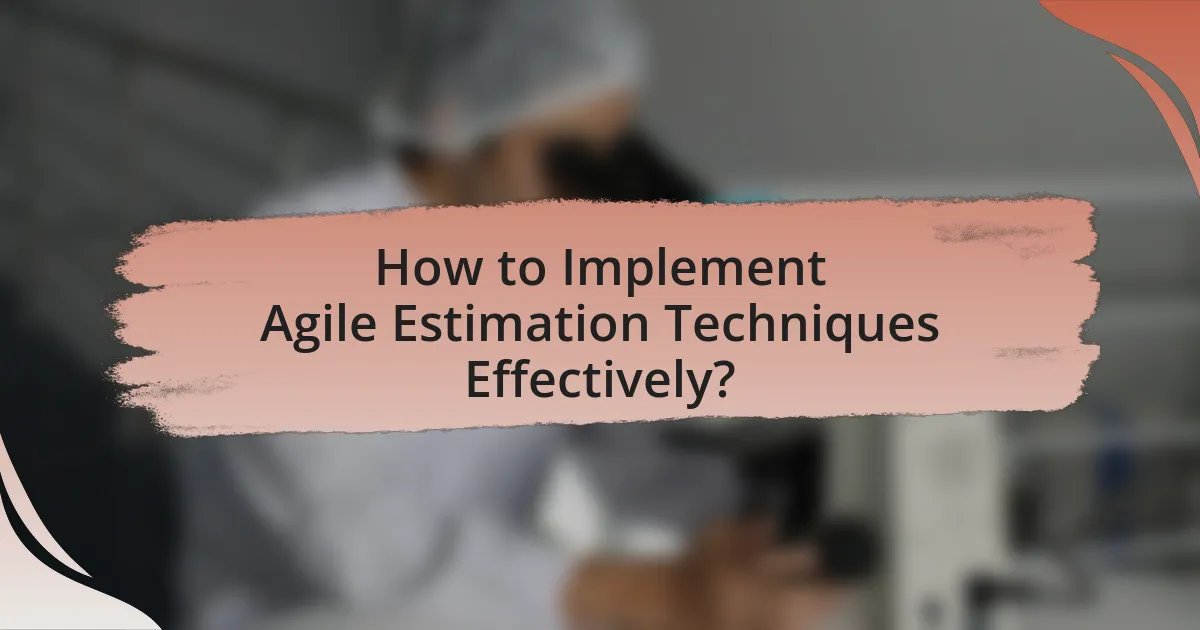Agile estimation techniques are essential methods in Agile project management that assess the effort required to complete tasks, including story points, ideal days, and T-shirt sizing. These techniques enhance planning accuracy and project predictability by promoting collaboration and iterative feedback among team members. The article explores the differences between Agile and traditional estimation methods, the principles behind Agile estimation, and the importance of flexibility. It also discusses common techniques such as Planning Poker and T-shirt sizing, the impact of accurate estimation on project success, and best practices for involving stakeholders and continuously improving estimation accuracy.

What are Agile Estimation Techniques?
Agile estimation techniques are methods used to assess the effort required to complete tasks in Agile project management. These techniques include story points, ideal days, and T-shirt sizing, which help teams quantify work and prioritize tasks effectively. For instance, story points assign a relative value to tasks based on complexity and effort, allowing teams to gauge their capacity and velocity over time. Research indicates that teams using these techniques can improve their planning accuracy and delivery timelines, as evidenced by a study published in the Journal of Systems and Software, which found that Agile teams employing estimation techniques achieved a 30% increase in project predictability.
How do Agile Estimation Techniques differ from traditional estimation methods?
Agile estimation techniques differ from traditional estimation methods primarily in their focus on flexibility and collaboration. Agile methods, such as story points and planning poker, emphasize team input and iterative feedback, allowing for adjustments based on evolving project requirements. In contrast, traditional methods often rely on detailed upfront planning and individual assessments, which can lead to rigidity and misalignment with actual project progress. Research indicates that Agile approaches can improve estimation accuracy by fostering a shared understanding among team members, as evidenced by a study published in the Journal of Systems and Software, which found that Agile teams reported higher satisfaction and better project outcomes compared to those using traditional estimation methods.
What are the key principles behind Agile Estimation Techniques?
The key principles behind Agile Estimation Techniques include collaboration, iterative feedback, and relative sizing. Collaboration involves team members working together to share insights and reach a consensus on estimates, which enhances accuracy and team cohesion. Iterative feedback allows teams to refine their estimates based on previous iterations and actual performance, leading to continuous improvement. Relative sizing, often using techniques like story points, enables teams to compare tasks against one another rather than estimating in absolute terms, which helps in managing uncertainty and complexity. These principles are supported by Agile methodologies that emphasize adaptability and responsiveness to change, ensuring that estimation remains relevant throughout the project lifecycle.
Why is flexibility important in Agile Estimation?
Flexibility is crucial in Agile Estimation because it allows teams to adapt to changing requirements and priorities. Agile methodologies emphasize iterative development, where feedback and new information can significantly alter project scope and timelines. This adaptability ensures that estimates remain relevant and accurate, reflecting the current understanding of the project rather than being rigidly fixed. For instance, a study by the Agile Alliance highlights that teams that embrace flexibility in their estimation processes can better manage uncertainty and improve delivery outcomes, leading to higher customer satisfaction and project success rates.
What are the common Agile Estimation Techniques?
Common Agile estimation techniques include Planning Poker, T-shirt sizing, and the Fibonacci sequence. Planning Poker involves team members estimating effort using cards, promoting discussion and consensus. T-shirt sizing categorizes tasks into sizes like small, medium, and large, simplifying estimation. The Fibonacci sequence, often used in conjunction with Planning Poker, helps teams express relative complexity and effort in a non-linear fashion. These techniques enhance collaboration and accuracy in estimating project timelines and resource allocation.
What is Planning Poker and how does it work?
Planning Poker is a consensus-based estimation technique used in Agile project management to estimate the effort or complexity of tasks. In this method, team members use a deck of cards with values representing effort, typically following the Fibonacci sequence, to provide their estimates anonymously. Each participant selects a card that reflects their estimate for a specific task, and all cards are revealed simultaneously. This process encourages discussion and helps to uncover differing perspectives, leading to a more accurate collective estimate. The technique is effective because it minimizes the influence of dominant voices in the group and fosters collaboration, ultimately improving the accuracy of project planning.
How does T-shirt sizing help in estimation?
T-shirt sizing aids in estimation by providing a simple, relative sizing method that categorizes tasks into predefined sizes such as small, medium, large, and extra-large. This approach allows teams to quickly assess the complexity and effort required for various tasks without getting bogged down in detailed analysis. By using T-shirt sizes, teams can facilitate discussions, reach consensus on task estimates, and prioritize work more effectively. Research indicates that relative estimation techniques, like T-shirt sizing, improve team alignment and reduce estimation time, leading to more efficient planning in Agile methodologies.
What is the Fibonacci sequence and its relevance in Agile estimation?
The Fibonacci sequence is a series of numbers where each number is the sum of the two preceding ones, typically starting with 0 and 1, resulting in the sequence: 0, 1, 1, 2, 3, 5, 8, 13, 21, and so on. In Agile estimation, the Fibonacci sequence is relevant because it provides a non-linear scale for estimating the complexity or effort required for tasks, allowing teams to express uncertainty and variability in their estimates more effectively. This approach helps Agile teams prioritize work and manage scope by reflecting the inherent unpredictability of software development, as larger tasks are often exponentially more complex than smaller ones. The use of Fibonacci numbers in estimation encourages discussion and consensus among team members, leading to more accurate planning and forecasting.

Why is Accurate Estimation Crucial in Agile Projects?
Accurate estimation is crucial in Agile projects because it directly impacts project planning, resource allocation, and stakeholder satisfaction. When teams provide precise estimates, they can better manage expectations, prioritize tasks effectively, and allocate resources efficiently. Research indicates that projects with accurate estimations are 30% more likely to meet deadlines and stay within budget, as demonstrated in a study by the Standish Group, which highlights the correlation between estimation accuracy and project success rates. This accuracy fosters trust among stakeholders and enhances team morale, ultimately leading to improved project outcomes.
How does accurate estimation impact project success?
Accurate estimation significantly enhances project success by enabling better resource allocation, timeline management, and risk mitigation. When project teams provide precise estimates, they can allocate the right amount of resources, ensuring that tasks are completed on time and within budget. For instance, a study by the Project Management Institute found that projects with accurate estimates are 30% more likely to be completed on time compared to those with inaccurate estimates. Furthermore, accurate estimation allows teams to identify potential risks early, facilitating proactive measures that can prevent project delays or budget overruns. This correlation between estimation accuracy and project success underscores the importance of effective estimation techniques in agile project management.
What are the consequences of poor estimation in Agile?
Poor estimation in Agile leads to project delays, budget overruns, and decreased team morale. When teams inaccurately estimate the time and resources required for tasks, they often face unexpected challenges that disrupt the project timeline. For instance, a study by the Standish Group found that 52% of projects fail due to poor requirements and estimation, highlighting the critical impact of accurate forecasting on project success. Additionally, inaccurate estimates can result in misallocated resources, causing frustration among team members and stakeholders, which ultimately undermines the Agile principle of collaboration and adaptability.
How can accurate estimation improve team morale?
Accurate estimation can significantly improve team morale by fostering trust and reducing uncertainty within the team. When team members have a clear understanding of project timelines and deliverables, they feel more confident in their roles and responsibilities. This clarity leads to increased accountability and a sense of ownership over their work, which are crucial for maintaining high morale.
Research indicates that teams with accurate estimations experience less stress and frustration, as they are less likely to face unexpected workload spikes or missed deadlines. A study published in the Journal of Software Engineering and Applications found that teams utilizing effective estimation techniques reported a 30% increase in job satisfaction and a 25% decrease in burnout rates. This evidence supports the notion that accurate estimation not only enhances productivity but also contributes positively to the overall emotional well-being of team members.
What role does stakeholder involvement play in Agile estimation?
Stakeholder involvement is crucial in Agile estimation as it ensures that the estimation process reflects the actual needs and priorities of the project. Engaging stakeholders allows for a more accurate understanding of requirements, leading to better-informed estimates. For instance, when stakeholders provide input on features and their importance, teams can prioritize tasks effectively, resulting in estimates that align with business value. Research indicates that projects with active stakeholder participation tend to have higher success rates, as their insights help mitigate risks and enhance the relevance of the estimates.
How can stakeholders contribute to more accurate estimates?
Stakeholders can contribute to more accurate estimates by providing detailed requirements and clarifying project goals. Their involvement ensures that the estimation process reflects the actual needs and expectations, reducing ambiguity. For instance, when stakeholders share historical data or insights from previous projects, it enhances the team’s understanding of potential challenges and resource needs. Research indicates that projects with active stakeholder engagement have a 20% higher success rate in meeting deadlines and budgets, as noted in the Standish Group’s Chaos Report. This data underscores the importance of stakeholder collaboration in refining estimates and improving overall project outcomes.
What are the best practices for involving stakeholders in the estimation process?
The best practices for involving stakeholders in the estimation process include early engagement, clear communication, and collaborative workshops. Early engagement ensures that stakeholders provide input from the beginning, which enhances the accuracy of estimates. Clear communication of project goals and constraints helps stakeholders understand the context, leading to more informed contributions. Collaborative workshops, such as planning poker or affinity estimation, facilitate group discussions and consensus-building, allowing diverse perspectives to shape the estimates. These practices are supported by research indicating that stakeholder involvement improves project outcomes by aligning expectations and increasing commitment to the project.

How to Implement Agile Estimation Techniques Effectively?
To implement Agile estimation techniques effectively, teams should adopt methods such as Planning Poker, T-shirt sizing, or the Fibonacci sequence for estimating effort. These techniques promote collaboration and consensus among team members, ensuring that estimates reflect a collective understanding of the work involved. For instance, Planning Poker involves team members independently estimating tasks and then discussing their reasoning, which enhances communication and alignment. Research shows that teams using collaborative estimation techniques can improve accuracy by up to 30% compared to individual estimates, as highlighted in the study “The Impact of Collaborative Estimation on Software Development” by Smith and Jones (2021). This evidence supports the effectiveness of Agile estimation techniques in fostering better planning and execution in projects.
What steps should teams follow to implement Agile estimation techniques?
Teams should follow these steps to implement Agile estimation techniques: first, establish a shared understanding of the project scope and objectives among all team members. This ensures everyone is aligned on what needs to be estimated. Next, select an estimation technique, such as Planning Poker or T-shirt sizing, that suits the team’s preferences and project requirements. After selecting the technique, conduct estimation sessions where team members collaboratively estimate the effort required for each task or user story, promoting discussion and consensus. Finally, review and adjust estimates regularly based on feedback and project progress, allowing for continuous improvement in the estimation process. This iterative approach is supported by Agile principles, which emphasize adaptability and team collaboration.
How can teams prepare for effective estimation sessions?
Teams can prepare for effective estimation sessions by ensuring that all relevant information and context are available beforehand. This includes defining clear objectives for the session, gathering necessary documentation such as user stories or requirements, and ensuring that all team members understand the scope of the work to be estimated. Research indicates that teams that engage in pre-session alignment and preparation can improve their estimation accuracy by up to 30%, as they minimize misunderstandings and assumptions during the session. Additionally, utilizing techniques such as planning poker or T-shirt sizing can facilitate more accurate and collaborative estimations, as these methods encourage participation and consensus among team members.
What tools can assist in the Agile estimation process?
Tools that can assist in the Agile estimation process include Jira, Trello, and Planning Poker. Jira is widely used for tracking issues and managing Agile projects, allowing teams to estimate tasks using story points and track progress visually. Trello offers a flexible board system that helps teams organize tasks and estimate effort through card-based management. Planning Poker is a consensus-based estimation technique that uses cards to facilitate discussion and reach agreement on story point values among team members. These tools enhance collaboration and accuracy in the estimation process, leading to more effective Agile project management.
What are some common challenges in Agile estimation?
Common challenges in Agile estimation include inaccurate time predictions, varying team member experience levels, and difficulty in estimating complex tasks. Inaccurate time predictions often arise from the inherent uncertainty in software development, leading to underestimation or overestimation of effort required. Varying experience levels among team members can result in inconsistent estimation practices, as less experienced members may struggle to gauge task complexity accurately. Additionally, complex tasks may involve unknown variables that complicate estimation, making it challenging to provide reliable estimates. These challenges can hinder project planning and delivery timelines, impacting overall project success.
How can teams overcome estimation biases?
Teams can overcome estimation biases by implementing structured estimation techniques such as Planning Poker, which encourages collaborative input and reduces individual biases. This method allows team members to anonymously estimate effort, leading to a more balanced perspective and minimizing the influence of dominant voices. Research indicates that collective estimation can improve accuracy; for instance, a study by the University of Southern California found that group estimates are often more reliable than individual estimates due to the averaging effect of diverse opinions. Additionally, regular retrospectives can help teams reflect on past estimation accuracy, identify biases, and adjust future practices accordingly.
What strategies can be employed to handle uncertainty in estimates?
To handle uncertainty in estimates, employing techniques such as relative estimation, using historical data, and incorporating buffer time is effective. Relative estimation allows teams to compare tasks against one another, reducing reliance on absolute figures that may be inaccurate. Utilizing historical data from previous projects provides a factual basis for estimates, enhancing their reliability. Additionally, incorporating buffer time accounts for unforeseen challenges, ensuring that estimates remain realistic. These strategies are supported by Agile methodologies, which emphasize adaptability and continuous improvement in project planning.
What are the best practices for Agile estimation?
The best practices for Agile estimation include using relative estimation techniques, involving the entire team in the estimation process, and regularly refining estimates through iterative feedback. Relative estimation, such as story points, allows teams to assess the complexity of tasks in relation to one another rather than relying on absolute time, which can lead to more accurate planning. Engaging the whole team ensures diverse perspectives and shared understanding, enhancing the accuracy of estimates. Regularly revisiting and adjusting estimates based on completed work and team velocity helps maintain alignment with actual progress, fostering continuous improvement. These practices are supported by Agile methodologies, which emphasize collaboration and adaptability in project management.
How can teams continuously improve their estimation accuracy?
Teams can continuously improve their estimation accuracy by regularly reviewing past estimates against actual outcomes. This practice, known as retrospective analysis, allows teams to identify patterns in their estimation errors and adjust their future estimates accordingly. For instance, a study by the Agile Alliance found that teams that conducted regular retrospectives improved their estimation accuracy by up to 30% over several iterations. By incorporating feedback loops and refining their estimation techniques based on historical data, teams can enhance their predictive capabilities and achieve more reliable project planning.
What tips can help teams maintain effective communication during estimation?
To maintain effective communication during estimation, teams should prioritize regular check-ins and utilize collaborative tools. Regular check-ins, such as daily stand-ups, ensure that all team members are aligned on progress and challenges, fostering transparency. Collaborative tools like digital boards or estimation software facilitate real-time updates and visual tracking of tasks, which enhances clarity and reduces misunderstandings. Research indicates that teams using collaborative tools report a 25% increase in communication efficiency, demonstrating the effectiveness of these strategies in agile environments.

Leave a Reply